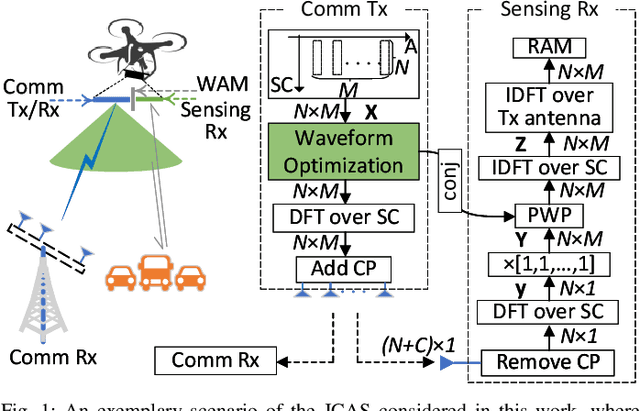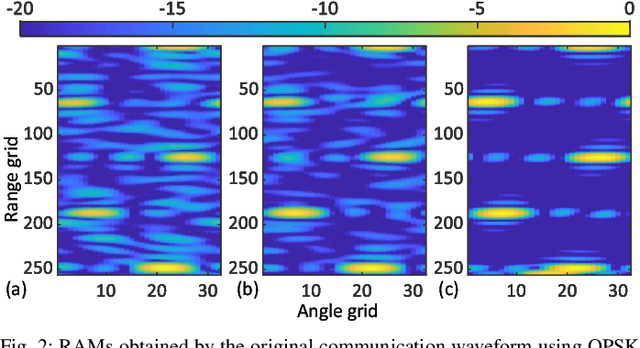Zhitong Ni
Deep Learning-based OTFS Channel Estimation and Symbol Detection with Plug and Play Framework
Mar 14, 2025Abstract:Orthogonal Time Frequency Space (OTFS) modulation has recently attracted significant interest due to its potential for enabling reliable communication in high-mobility environments. One of the challenges for OTFS receivers is the fractional Doppler that occurs in practical systems, resulting in decreased channel sparsity, and then inaccurate channel estimation and high-complexity equalization. In this paper, we propose a novel unsupervised deep learning (DL)-based OTFS channel estimation and symbol detection scheme, capable of handling different channel conditions, even in the presence of fractional Doppler. In particular, we design a unified plug-and-play (PnP) framework, which can jointly exploit the flexibility of optimization-based methods and utilize the powerful data-driven capability of DL. A lightweight Unet is integrated into the framework as a powerful implicit channel prior for channel estimation, leading to better exploitation of the channel sparsity and the characteristic of the noise simultaneously. Furthermore, to mitigate the channel estimation errors, we realize the PnP framework with a fully connected (FC) network for symbol detection at different noise levels, thereby enhancing robustness. Finally, numerical results demonstrate the effectiveness and robustness of the algorithm.
High-Resolution Uplink Sensing in Millimeter-Wave ISAC Systems
Mar 13, 2025Abstract:Perceptive mobile networks (PMNs), integrating ubiquitous sensing capabilities into mobile networks, represent an important application of integrated sensing and communication (ISAC) in 6G. In this paper, we propose a practical framework for uplink sensing of angle-of-arrival (AoA), Doppler, and delay in millimeter-wave (mmWave) communication systems, which addresses challenges posed by clock asynchrony and hybrid arrays, while being compatible with existing communication protocols. We first introduce a beam scanning method and a corresponding AoA estimation algorithm, which utilizes frequency smoothing to effectively estimate AoAs for both static and dynamic paths. We then propose several methods for constructing a ``clean'' reference signal, which is subsequently used to cancel the effect caused by the clock asynchrony. We further develop a signal ratio-based joint AoA-Doppler-delay estimator and propose an AoA-based 2D-FFT-MUSIC (AB2FM) algorithm that applies 2D-FFT operations on the signal subspace, which accelerates the computation process with low complexity. Our proposed framework can estimate parameters in pairs, removing the complicated parameter association process. Simulation results validate the effectiveness of our proposed framework and demonstrate its robustness in both low and high signal-to-noise ratio (SNR) conditions.
Uplink Sensing Using CSI Ratio in Perceptive Mobile Networks
Nov 07, 2022Abstract:Uplink sensing in perceptive mobile networks (PMNs), which uses uplink communication signals for sensing the environment around a base station, faces challenging issues of clock asynchronism and the requirement of a line-of-sight (LOS) path between transmitters and receivers. The channel state information (CSI) ratio has been applied to resolve these issues, however, current research on the CSI ratio is limited to Doppler estimation in a single dynamic path. This paper proposes an advanced parameter estimation scheme that can extract multiple dynamic parameters, including Doppler frequency, angle-of-arrival (AoA), and delay, in a communication uplink channel and completes the localization of multiple moving targets. Our scheme is based on the multi-element Taylor series of the CSI ratio that converts a nonlinear function of sensing parameters to linear forms and enables the applications of traditional sensing algorithms. Using the truncated Taylor series, we develop novel multiple-signal-classification grid searching algorithms for estimating Doppler frequencies and AoAs and use the least-square method to obtain delays. Both experimental and simulation results are provided, demonstrating that our proposed scheme can achieve good performances for sensing both single and multiple dynamic paths, without requiring the presence of a LOS path.
Joint Communications and Sensing Employing Optimized MIMO-OFDM Signals
Aug 21, 2022



Abstract:Joint communication and sensing (JCAS) has the potential to improve the overall energy, cost and frequency efficiency of IoT systems. As a first effort, we propose to optimize the MIMO-OFDM data symbols carried by sub-carriers for better time- and spatial-domain signal orthogonality. This not only boosts the availability of usable signals for JCAS, but also significantly facilitates Internet-of-Things (IoT) devices to perform high-quality sensing. We establish an optimization problem that modifies data symbols on sub-carriers to enhance the above-mentioned signal orthogonality. We also develop an efficient algorithm to solve the problem based on the majorization-minimization framework. Moreover, we discover unique signal structures and features from the newly modeled problem, which substantially reduce the complexity of majorizing the objective function. We also develop new projectors to enforce the feasibility of the obtained solution. Simulations show that, compared with the original communication waveform to achieve the same sensing performance, the optimized waveform can reduce the signal-to-noise ratio (SNR) requirement by 3~4.5 dB, while the SNR loss for the uncoded bit error rate is only 1~1.5 dB.
 Add to Chrome
Add to Chrome Add to Firefox
Add to Firefox Add to Edge
Add to Edge